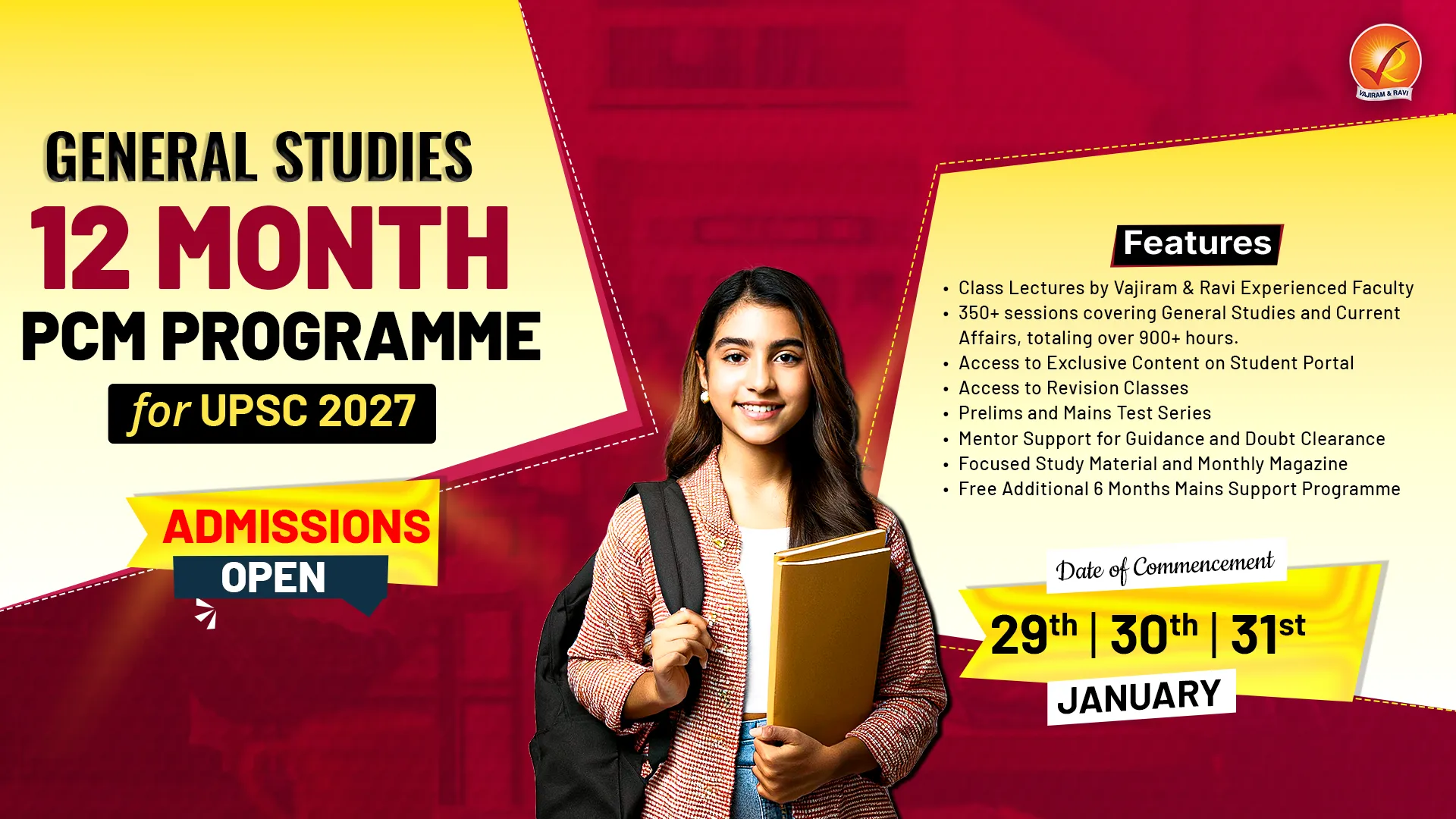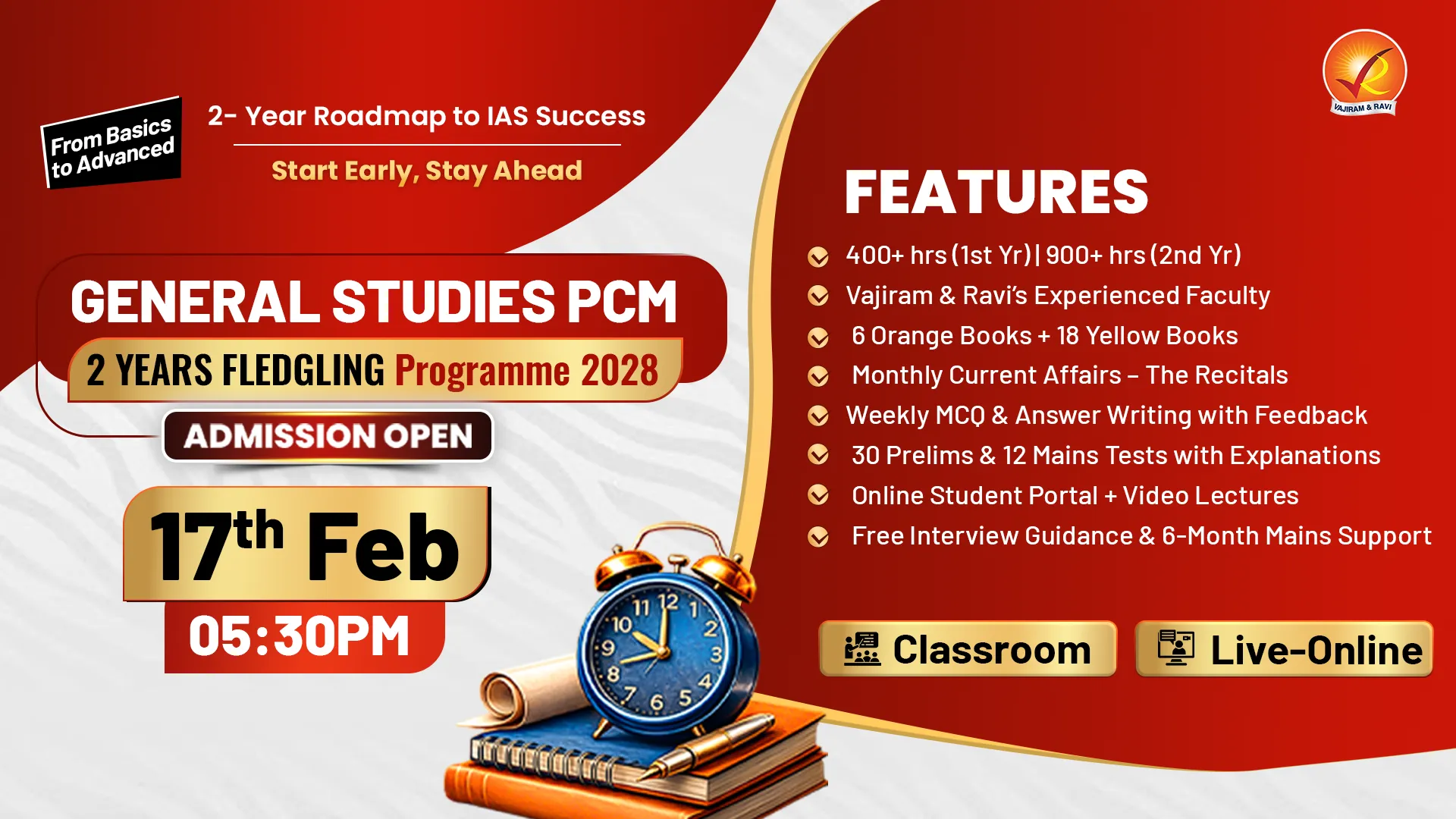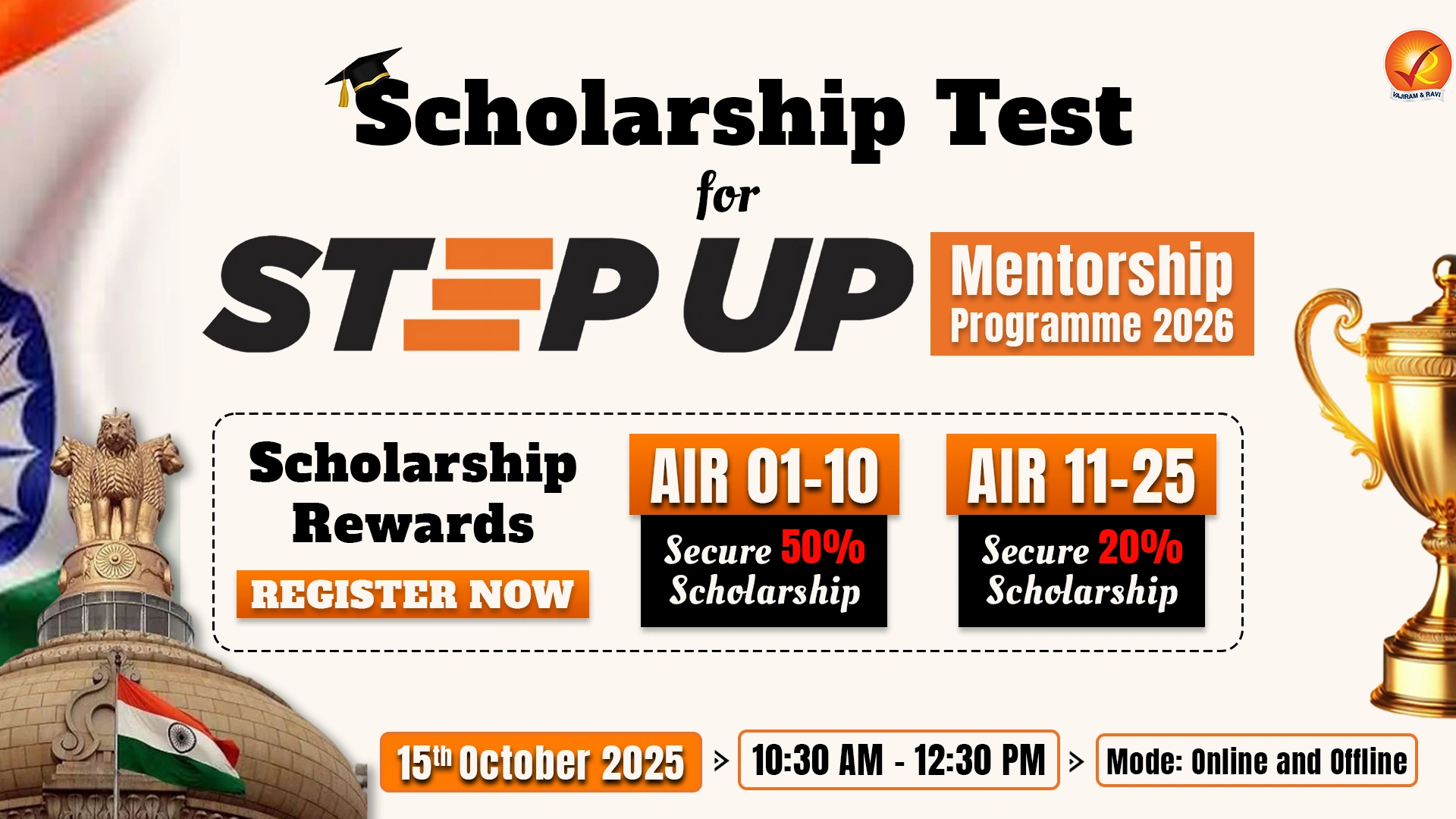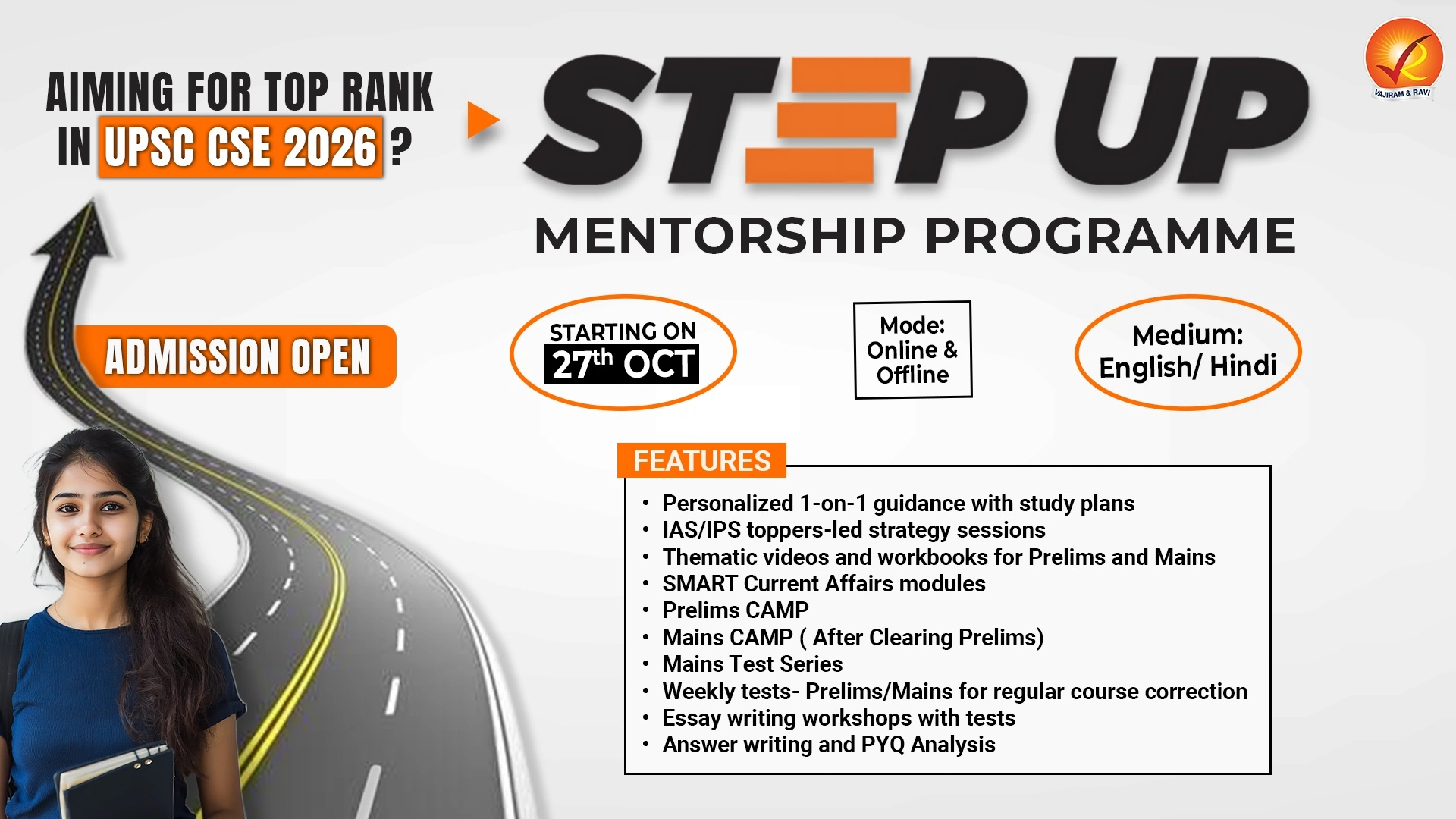Upcoming Mentoring Sessions
RMS - Economy - Industry, Infrastructure & Investment Models
RMS - Polity - DPSP & FD
RMS - Economy - Indian Agriculture - Part II
RMS - Geography - Rocks & Volcanoes and its landforms
RMS - Geography - Evolution of Oceans & Continents
RMS - Polity - Fundamental Rights - P1
RMS - Modern History - 1498 AD to 1757 AD
RMS - Modern History - 1858 AD to 1919 AD
RMS - Geography - Interior of the Earth & Geomorphic Processes
RMS - Geography - Universe and Earth and Basic concepts on Earth
RMS - Economy - Indian Agriculture - Part I
RMS - Economy - Fundamentals of the Indian Economy
RMS - Polity - Union & its territories and Citizenship
RMS - Polity - Constitution & its Salient Features and Preamble
Learning Support Session - ANSWER writing MASTER Session
Learning Support Session - How to Read Newspaper?
Mastering Art of writing Ethics Answers
Mastering Art of Writing Social Issues Answers
Answer Review Session
Mentoring Session - UPSC Form Filling
Mentoring Session (2024 - 25) - How to Write an ESSAY?
Social Issues Doubts and Mentoring Session
Ethics & Essay Doubts and Mentoring Session
Geography & Environment Doubts and Mentoring Session
History Doubts and Mentoring Session
Economy & Agriculture Doubts and Mentoring Session
Online Orientation Session
How to Read Newspaper and Make Notes?
Mains Support Programme 2025-(2)
Mains Support Programme 2025- (1)
Polity & International Relations Doubts and Mentoring Session
Mentoring Sessions (2024-25) - How to DO REVISION?
Learning Support Session - How to Start Preparation?
RMS - Geography - World Mapping
Prelims 2024 Strategy Session
Mentoring Session (2024-25) - How to Make Notes?
General Mentoring Session (GMS )
Mentoring Session (2025-26) - How to write an Answer?
Current Affairs
Jan. 15, 2026
Key Facts about Konda Reddi Tribe
At least 38 thatched houses belonging to members of the Konda Reddi tribe have been gutted in a fire mishap reportedly due to a short circuit at Sarlanka village in Prathipadu Mandal in Kakinada district, Andhra Pradesh, recently.
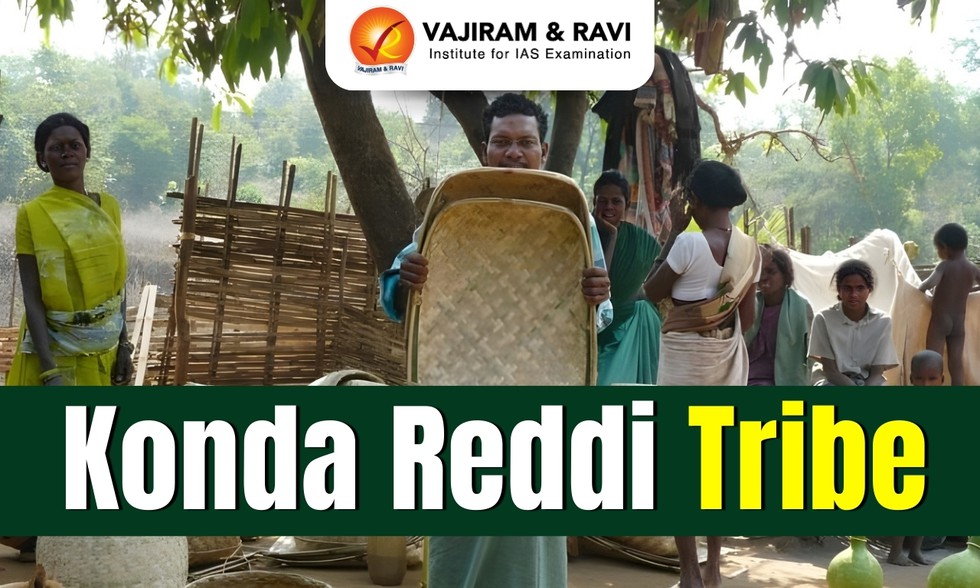
About Konda Reddi Tribe:
- Konda Reddis is a Particularly Vulnerable Tribal Group (PVTG) inhabiting the banks situated on either side of the Godavari River in the hilly and forest tracts of the East and West Godavari and Khammam districts of Andhra Pradesh.
- Language: Their mother tongue is Telugu in its purest and chaste form and a unique accent.
- Religion:
- The primary religion practiced by the Konda Reddi is Folk Hinduism, characterized by local traditions and cults of local deities worshiped at the community level.
- Their main festivals are Ugadi, Akshade, and Dussehra.
- Family and Marriage:
- The family is patriarchal and patrilocal. Monogamy is a rule, but polygamous families are also found.
- Marriage by negotiations, by love and elopement, by service, by capture, and by exchange are socially accepted ways of acquiring mates.
- Political Organization:
- They have their own institution of social control called ‘Kula Panchayat’.
- Each village has a traditional headman called ‘Pedda Kapu’.
- The office of the headman is hereditary, and the headman is also the Pujari (priest) of the village deities.
- Livelihood:
- They are primarily shifting cultivators and largely depend on the flora and fauna of forest for their livelihood.
- They eat a variety of tubers, roots, leaves, wild fruits,
- They collect and sell non-timber forest produce like tamarind, adda leaves, myrobolan, broomsticks etc., to supplement their meagre income.
- They largely cultivate jowar, which is their staple food.
- The Konda Reddi tribe’s way of life largely revolves around the cow, which is a source of sustenance for them.
- These tribal people are aggressive in the cultivation of commercial crops such as cashew, niger, chilli, and cotton under the Podu cultivation method.
- The tribe has adopted a unique circular-shaped architecture for housing. The houses, built with circular mud walls and thatched roofs, resemble the Bhunga architecture of Gujarat’s Kachchh region.
Geography
Current Affairs
Jan. 15, 2026
What is the Miyawaki Method?
The Miyawaki method can be used in cities where green space has thinned out over decades.
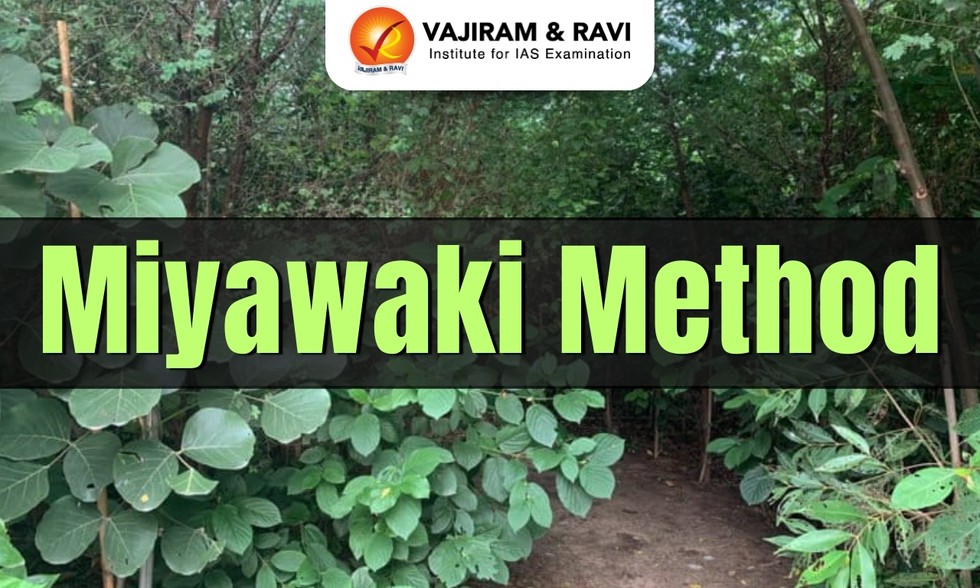
About Miyawaki Method:
- This method of afforestation was developed by renowned Japanese botanist Akira Miyawaki in the 1970s.
- It is a revolutionary method for creating dense forests in limited spaces.
- It is often referred to as the ‘pot plantation method’, it involves planting trees and shrubs close to one another to accelerate their growth.
- The competition for sunlight encourages trees to grow more vertically and less laterally.
- It emphasises planting only plant species native to the local area. This fosters a more resilient and naturally balanced ecosystem.
- Plants grow 10 times faster with this technique, making it a practical solution for urban areas.
- They are much denser and house much more biodiversity — just like ancient, primordial forests.
- For the first two to three years, the forest requires regular watering, weeding, and monitoring.
- After this period, the forest becomes self-sustaining and requires minimal intervention.
- Advantages:
- It improves soil quality, enhances biodiversity, and accelerates forest development.
- Trees planted using the Miyawaki technique absorb more carbon, grow faster, and support richer biodiversity compared to traditional forests.
- In urban settings, this technique has transformed polluted, barren lands into green ecosystems.
- It has successfully managed industrial waste, reduced dust and foul odours, and curbed air and water pollution.
- Additionally, it prevents soil erosion and promotes ecological balance, making it an effective tool for environmental restoration.
Environment
Current Affairs
Jan. 15, 2026
What is Huntington's Disease (HD)?
Huntington's disease (HD) has long been impossible to cure, but new research is finally giving fresh hope.

About Huntington's Disease (HD):
- It is a rare hereditary disorder in which brain cells, or neurons, in certain areas of your brain start to break down.
- The destruction of nerve cells happens in the basal ganglia, or the region of your brain that regulates your body’s movements.
- It also affects the brain cortex (surface of your brain) that regulates your thinking, decision-making, and memory.
- As the neurons degenerate, the disease can lead to emotional disturbances, loss of intellectual abilities, and uncontrolled movements.
- What causes HD?
- A genetic mutation of the HTT gene causes HD. If one of your parents has HD, you have a 50% chance of also developing it.
- The HTT gene makes a protein called huntingtin. This protein helps your nerve cells (neurons) function.
- If you have HD, your DNA doesn’t have all the information needed to make the huntingtin protein.
- As a result, these proteins grow in an abnormal shape and destroy (instead of help) your neurons.
- Your neurons die because of this genetic mutation.
- There are two main types of HD:
- Adult-onset: This is the most common Symptoms usually start after age 30.
- Early-onset (juvenile Huntington’s disease): This rare type affects children and teenagers. Symptoms appear before age 20.
- Symptoms:
- Common symptoms include uncontrollable dance-like movements (chorea) and abnormal body postures, as well as problems with behavior, emotion, thinking, and personality.
- Other symptoms may include tremor (unintentional back-and-forth movement in the person’s muscles) and unusual eye movements. The eye movements can happen early in the disease.
- These symptoms get worse over time.
- As HD progresses, you will need constant assistance and supervision because of the debilitating nature of the disease.
- Treatment: There is no treatment that can stop or reverse HD, but health care providers can offer medications to help with certain symptoms.
Science & Tech
Current Affairs
Jan. 15, 2026
What is Gharial?
Despite significant existential threats, a comprehensive survey across the Ganga River basin recently revealed a population of 3,037 gharials (Gavialis gangeticus), the critically endangered fish-eating crocodile, inhabiting 13 of the surveyed rivers.

About Gharial:
- It is a freshwater crocodile belonging to the Crocodylia Order and Crocodylidae Family.
- Scientific Name: Gavialis gangeticus
- The name ‘gharial’ comes from the Hindi word ghara, meaning pot or vessel, referring to the bulbous snout tip of adult males, which resembles an inverted pot.
- Distribution:
- Its range spanned the rivers of Bangladesh, Bhutan, India, Myanmar, Nepal, and Pakistan.
- Their major population occurs in three tributaries of the Ganga River: the Chambal and Girwa Rivers in India and the Rapti-Naryani River in Nepal.
- The Gharial reserves of India are located in three States: Uttar Pradesh, Madhya Pradesh, and Rajasthan.
- Features:
- It is one of the largest crocodilian
- They have thick skin covered with smooth epidermal scales that do not overlap.
- The snout of the gharial is uniquely the thinnest and most elongated among all the crocodilians.
- In addition, the adult males sport a large bulb at the tip of their snout, called the ‘ghara’.
- It is also the most aquatic of all crocodilians, for it never moves far from the water. Individuals typically only leave the water to bask and nest on sandbanks.
- Reproduction: They mate during November–January and lay eggs March–May.
- Conservation Status:
- IUCN Red List: Critically endangered.
Environment
Current Affairs
Jan. 15, 2026
Asola-Bhatti Wildlife Sanctuary
The Delhi government recently said that over 6,500 monkeys rescued by civic bodies from residential and commercial areas across the city have been shifted to Asola-Bhatti Wildlife Sanctuary in the last five years.
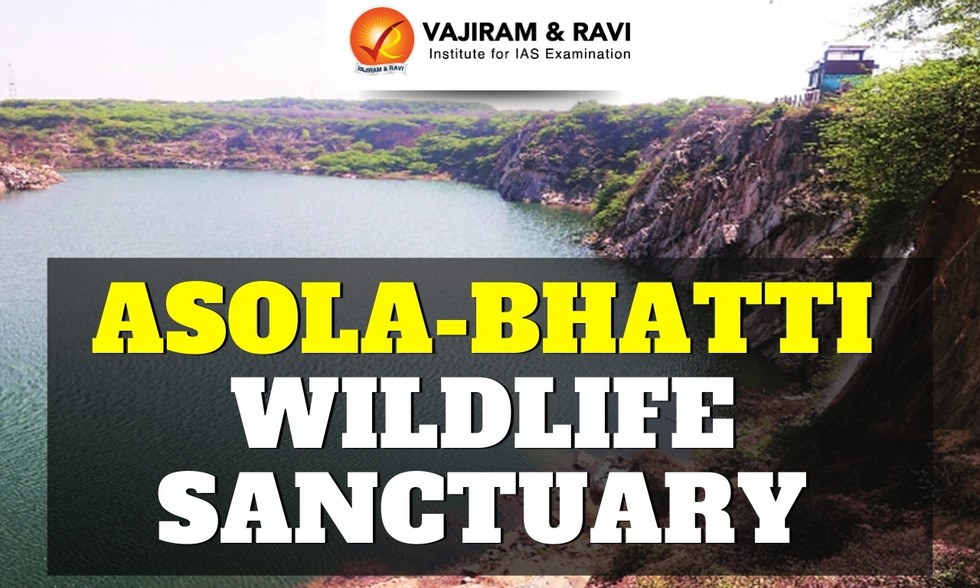
About Asola-Bhatti Wildlife Sanctuary:
- Asola-Bhatti Wildlife Sanctuary, on the Southern Delhi Ridge of the Aravalli hill range on the Delhi-Haryana border, lies in Southern Delhi as well as the northern parts of Faridabad and Gurugram districts of Haryana state.
- It is part of the Northern Aravalli Leopard Wildlife Corridor.
- In Delhi, Sanctuary passes through historical sites such as Chattarpur Temple, Tughlakabad, Surajkund, Anangpur Dam, and Adilabad Ruins.
- Flora:
- The semi-arid forest vegetation of the Aravali region provides homes to certain plant species.
- It includes dhak (flame of the forest), babool (Acacia), khejri, and various shrubs and grasses that are well-adapted to dry conditions.
- Fauna:
- It is home to a wide variety of animals, including the Indian leopard, jackal, Indian blue bull, sambar deer, wild boar, and mongoose.
- It is also a birdwatcher’s paradise, with various birds spotted here, including the Indian peafowl, crested serpent-eagle, and Indian roller.
- Reptiles such as the monitor lizard, Indian cobra, and Russell’s viper can also be found here.
Environment
Current Affairs
Jan. 15, 2026
Henley Passport Index
The 2026 Henley Passport Index has shown significant shifts in global travel mobility, with Asia continuing to dominate the top ranks.

About Henley Passport Index:
- It is a popular ranking of global passports that measures passport strength by the number of destinations that holders can visit without a prior visa.
- Base: The index ranks countries based on statistics provided by the International Air Transport Association (IATA).
- Significance: The stronger the passport, the more countries its holders can enter without a prior visa, a privilege that reflects diplomatic ties, economic influence, and international trust.
Key Highlights of Henley Passport Index 2026:
- India’s passport also saw improvement, climbing five spots to 80th position
- The top three passports in the world come from Asia. Singapore ranks first, while Japan and South Korea are tied for second place.
- Afghanistan is at the bottom of the list, ranked 101st, with visa-free access to 24 destinations.
Polity & Governance
Current Affairs
Jan. 15, 2026
Havana Syndrome
Recently, a covertly acquired device by Pentagon that emits pulsed radio waves is under US testing, reopening questions around Havana Syndrome.

About Havana Syndrome:
- It refers to a set of mental health symptoms that are said to be experienced by United States intelligence and embassy officials in various countries.
- It does not mean a unique medical condition, but rather a set of symptoms that are usually experienced together whose origins may be difficult to confirm.
- Symptoms: Such as hearing certain sounds without any outside noise, nausea, vertigo and headaches, memory loss and balance issues.
Science & Tech
Current Affairs
Jan. 15, 2026
NPS Vatsalya Scheme
Recently, the Pension Fund Regulatory and Development Authority (PFRDA) has issued the NPS Vatsalya Scheme Guidelines 2025.

About NPS Vatsalya Scheme:
- It is a contributory savings and long term financial security scheme designed exclusively for minors.
- Key features of NPS Vatsalya Scheme:
- Eligibility: It is open to all Indian citizens, including NRI/OCI, below 18 years of age.
- Account Operation: Account opened in the name of the minor and operated by the guardian
- Contribution: Minimum initial and annual contribution ₹250 and no maximum limit on contribution
- The contribution can also be gifted by relatives and friends.
- Pension Fund Selection: Guardian can choose any one Pension Fund registered with PFRDA
- Partial Withdrawal Provisions: It is allowed after completion of three years from account opening
- Up to 25% of own contributions (excluding returns) is permitted for education, medical treatment and specified disabilities
- It is allowed twice before 18 years and twice between 18-21 years, subject to conditions.
Polity & Governance
Current Affairs
Jan. 15, 2026
Molecular Cloud
Recently, astronomers studied the L328 molecular cloud, located around 700 light years away, to map the magnetic fields at multiple scales.

About Molecular Cloud:
- It is an interstellar cloud of gas and dust in which molecules can form, the most common of which is Hydrogen (H2).
- Properties of Molecular Cloud:
- These are characterized by their low temperatures (below 40 K, colder than liquid nitrogen) and relatively high densities.
- Size: The size of these clouds can be from a few light years up to 600 light years. Their total mass can reach several million solar masses.
- Molecular clouds with dimensions of more than about 15 light years are also called giant molecular clouds.
- The complex interplay between three key forces, namely gravity, magnetic fields, and turbulence, determines how these clouds collapse to form stars.
- The central regions of these clouds are completely hidden from view by dust.
- They are the raw material of stars and planets. These clouds do not last for a very long time.
- After the new stars are born, their solar winds blow away the remaining gas and dust.
- Significance of Molecular Cloud:
- Molecular clouds are so important because they are the raw material of stars and planets.
- It is thought to be the birthplace of stars and planetary systems through processes of contraction, condensation, and accretion.
Science & Tech
Current Affairs
Jan. 15, 2026
Export Preparedness Index 2024
Recently, NITI Aayog released the Export Preparedness Index (EPI) 2024.

About Export Preparedness Index 2024:
- It is a comprehensive assessment of export readiness across India’s States and Union Territories (UTs).
- It recognises the diversity of subnational economic structures and their critical role in advancing India’s global trade ambitions.
- The first edition of the EPI was published in August 2020 and this is the 4th edition.
- Framework and Coverage: It is structured around four pillars, further disaggregated into 13 sub-pillars and 70 indicators. Four Pillars are:
- Export Infrastructure (20% Weightage)
- Business Ecosystem (40% Weightage)
- Policy and Governance (20% Weightage)
- Export Performance (20% Weightage)
- Classification of States and Union Territories: States and UTs have been categorised into Large States & Small States, North East States and Union Territories.
- Within each category, they are further classified as
- Leaders: States/UTs demonstrating relatively high export preparedness
- Challengers: States/UTs with moderate preparedness and scope for improvement
- Aspirers: States/UTs at early stages of export ecosystem development
- Under EPI 2024, the following States and UTs have emerged as leading performers in their respective categories:
- Leading Performers
- Large States: Maharashtra, Tamil Nadu, Gujarat, Uttar Pradesh, Andhra Pradesh
- Small States, North Eastern States & Union Territories: Uttarakhand, Jammu and Kashmir, Nagaland, Dadra and Nagar Haveli & Daman and Diu, Goa.
- Leading Performers
Economy

